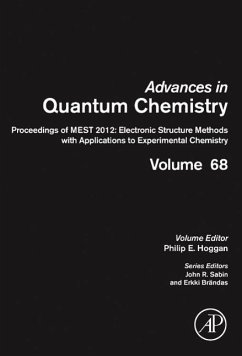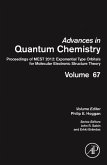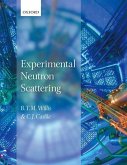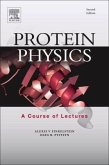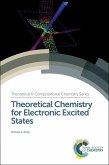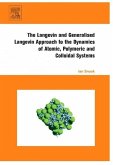Philip E. Hoggan
Proceedings of Mest 2012: Electronic Structure Methods with Applications to Experimental Chemistry
Volume 68
Philip E. Hoggan
Proceedings of Mest 2012: Electronic Structure Methods with Applications to Experimental Chemistry
Volume 68
- Gebundenes Buch
- Merkliste
- Auf die Merkliste
- Bewerten Bewerten
- Teilen
- Produkt teilen
- Produkterinnerung
- Produkterinnerung
Advances in Quantum Chemistry presents surveys of current topics in this rapidly developing field that has emerged at the cross section of the historically established areas of mathematics, physics, chemistry, and biology. It features detailed reviews written by leading international researchers. This volume focuses on the theory of heavy ion physics in medicine.
Andere Kunden interessierten sich auch für
![Proceedings of Mest 2012: Exponential Type Orbitals for Molecular Electronic Structure Theory Proceedings of Mest 2012: Exponential Type Orbitals for Molecular Electronic Structure Theory]() Proceedings of Mest 2012: Exponential Type Orbitals for Molecular Electronic Structure Theory135,99 €
Proceedings of Mest 2012: Exponential Type Orbitals for Molecular Electronic Structure Theory135,99 €![Experimental Neutron Scattering Experimental Neutron Scattering]() B. T. M. Willis (University of Lund Department of Physics)Experimental Neutron Scattering72,99 €
B. T. M. Willis (University of Lund Department of Physics)Experimental Neutron Scattering72,99 €![Protein Physics Protein Physics]() Alexei V. FinkelsteinProtein Physics80,99 €
Alexei V. FinkelsteinProtein Physics80,99 €![Protein Physics Protein Physics]() Alexei V. FinkelsteinProtein Physics60,99 €
Alexei V. FinkelsteinProtein Physics60,99 €![Theoretical Chemistry for Electronic Excited States Theoretical Chemistry for Electronic Excited States]() Michael A Robb (UK Imperial College London)Theoretical Chemistry for Electronic Excited States214,99 €
Michael A Robb (UK Imperial College London)Theoretical Chemistry for Electronic Excited States214,99 €![The Langevin and Generalised Langevin Approach to the Dynamics of Atomic, Polymeric and Colloidal Systems The Langevin and Generalised Langevin Approach to the Dynamics of Atomic, Polymeric and Colloidal Systems]() Ian SnookThe Langevin and Generalised Langevin Approach to the Dynamics of Atomic, Polymeric and Colloidal Systems86,99 €
Ian SnookThe Langevin and Generalised Langevin Approach to the Dynamics of Atomic, Polymeric and Colloidal Systems86,99 €![Proteins at Liquid Interfaces Proteins at Liquid Interfaces]() D. Möbius / R. Miller (eds.)Proteins at Liquid Interfaces176,99 €
D. Möbius / R. Miller (eds.)Proteins at Liquid Interfaces176,99 €-
-
-
Advances in Quantum Chemistry presents surveys of current topics in this rapidly developing field that has emerged at the cross section of the historically established areas of mathematics, physics, chemistry, and biology. It features detailed reviews written by leading international researchers. This volume focuses on the theory of heavy ion physics in medicine.
Produktdetails
- Produktdetails
- Advances in Quantum Chemistry Volume 68
- Verlag: Academic Press / Elsevier Science & Technology
- Artikelnr. des Verlages: C2013-0-19053-8
- Seitenzahl: 336
- Erscheinungstermin: 17. Januar 2014
- Englisch
- Abmessung: 228mm x 150mm
- Gewicht: 590g
- ISBN-13: 9780128005361
- ISBN-10: 012800536X
- Artikelnr.: 41242675
- Advances in Quantum Chemistry Volume 68
- Verlag: Academic Press / Elsevier Science & Technology
- Artikelnr. des Verlages: C2013-0-19053-8
- Seitenzahl: 336
- Erscheinungstermin: 17. Januar 2014
- Englisch
- Abmessung: 228mm x 150mm
- Gewicht: 590g
- ISBN-13: 9780128005361
- ISBN-10: 012800536X
- Artikelnr.: 41242675
Born in Aberystwyth, Wales and educated at Trinity College Cambridge, Philip Hoggan has always been French and British. After a mathematical chemistry background, he has studied a number of theoretical systems, with a DSc by research obtained in 1991 at Nancy, France on the way physical interaction between molecules and solid surfaces is a precursor to catalysis. This was treated entirely on the basis of Quantum Mechanics and applied, first to cis-trans butadiene isomerization on alumina and then a number of 'organic' reactions. The first lectureship was at Caen, Normandy from 1992. This period led to some fundamental research of ab initio Slater electronic structure calculations for more than 3 atoms. The first related code STOP was published in February 1996 after much work by a postdoctoral fellow A. Bouferguène, now Professor at U Alberta. After continuing to study catalytic systems at Caen, from a theoretical viewpoint, Philip Hoggan was appointed to the Chair of Theoretical Chemistry in Clermont from May 1998. This is still essentially his teaching position, although research interests have switched to solid-state (surface) physics joining the Pascal Institute for physics in Clermont from 2005. This followed a visiting professor stay of 18 months at Tallahassee, Florida in Theoretical Physics. Research emphasis has shifted from the STOP era (where the problem was solved by Coulomb Resolution in 2008) to Quantum Monte Carlo (QMC). The CNRS paid leave for a couple of years for Philip Hoggan to learn about this technique from Cyrus Umrigar, Julien Toulouse, Michel Caffarel and others. Of course, it eventually led to a project to calculate catalytic reactions on metal surfaces that was initiated by G-J Kroes (Leiden, NL) and his ERC in 2014. K Doblhoff-Dier arrived in Clermont for a ground-breaking research fellowship and each of us continues to produce very accurate work e.g. on hydrogen (production and dissociation on metals), as a clean fuel for renewable energy. Now, in 2023 we enter the 400th anniversary of Blaise Pascal's birth. He invented calculators, some of which are in the Clermont museum. It is wonderful to work in the institute that bears his name conducting QMC on catalytic hydrogen synthesis on super-calculators: the tools that trace their roots to his 'Pascaline'. Philip Hoggan is married and has twin daughters.
On the Convergence of the Interpenetrating Bipolar Expansion for the Coulomb Potential - Harris J. SilverstoneBehavior Preserving Extension of Univariate and Bivariate Functions - David LevinAsymptotic Expansions of Barnett-Coulson-Lowdin Functions of High Order - Avram Sidi, Didier Pinchon and Philip E. HogganSelf-Consistent-Field Using Direct Inversion in Iterative Subspace Method and Quasi-Newton Vectors - Joshua J. Goings, Feizhi Ding and Xiaosong LiRelative Advantages of Quantum Monte Carlo Simulation for Changing Electron Correlation: CO Reactions on Copper and Platinum Catalysts - Philip E. Hoggan and Ahmed BoufergueneOEP Orbitals as a Reference for ab initio Many-Body Calculations - Adam Buksztel, Szymon Smiga and Ireneusz GrabowskiDensity-Dependent Exchange-Correlation Potentials Derived from Highly Accurate ab initio Calculations - Szymon Smiga, Adam Buksztel and Ireneusz GrabowskiPotential Energy Curves via Double Ionization Potential Calculations: Example of HF Molecule - Monika Musial, Justyna Cembrzynska, and Leszek MeissnerA Density Functional Theory Study of the Adsorption of 2-Cyclohexenone on Rh(111) - R. Ghomari, A. Bouferguene, P. E. Hoggan and S. M. MekellecheThe (SiH)3+ Quasi-Molecule in the Adiabatic Representation - D. C. Joseph, B. C. Saha, J-P. Gu, H. P. Liebermann, P. Funke and R. J. BuenkerSystematic Study of the Electronic Properties and Trends in the LiX (X=Na, K, Rb, Cs and Fr) Molecules - S. Bellayouni, I. Jendoubi, N. Mabrouk and H. BerricheIsotopic Effects in the Li+-Li Collisions at Lower and Higher Temperatures - F. Bouchelaghem and M. BouledrouaTheoretical Investigation of The Intramolucular H-Bonding on Tautomerism - Ismahan Lafifi and DjamelEddine Khatmiß-cyclodextrin Interaction with Edaravone: Molecular Modeling Study - Mohamed Rahim, Leila Nouar, Sakina Haiahem, Fatiha Madi, Fateh Djebnoune and DjamelEddine Khatmi Molecular Modeling Study of Neutral and Cationic Species of Ortho-Anisidine by ß-Cyclodextrin - Imene Djilani, Leila Nouar, Fatiha Madi, Sakina Haiahem, Abdelaziz Bouhadiba and DjamelEddine Khatmi First Principles Calculations of Electronic and Optical Properties of LiAlH4 in its Monoclinic and Tetragonal Phases - Sacia Djeroud and Farouk Adjailia
On the Convergence of the Interpenetrating Bipolar Expansion for the Coulomb Potential - Harris J. SilverstoneBehavior Preserving Extension of Univariate and Bivariate Functions - David LevinAsymptotic Expansions of Barnett-Coulson-Lowdin Functions of High Order - Avram Sidi, Didier Pinchon and Philip E. HogganSelf-Consistent-Field Using Direct Inversion in Iterative Subspace Method and Quasi-Newton Vectors - Joshua J. Goings, Feizhi Ding and Xiaosong LiRelative Advantages of Quantum Monte Carlo Simulation for Changing Electron Correlation: CO Reactions on Copper and Platinum Catalysts - Philip E. Hoggan and Ahmed BoufergueneOEP Orbitals as a Reference for ab initio Many-Body Calculations - Adam Buksztel, Szymon Smiga and Ireneusz GrabowskiDensity-Dependent Exchange-Correlation Potentials Derived from Highly Accurate ab initio Calculations - Szymon Smiga, Adam Buksztel and Ireneusz GrabowskiPotential Energy Curves via Double Ionization Potential Calculations: Example of HF Molecule - Monika Musial, Justyna Cembrzynska, and Leszek MeissnerA Density Functional Theory Study of the Adsorption of 2-Cyclohexenone on Rh(111) - R. Ghomari, A. Bouferguene, P. E. Hoggan and S. M. MekellecheThe (SiH)3+ Quasi-Molecule in the Adiabatic Representation - D. C. Joseph, B. C. Saha, J-P. Gu, H. P. Liebermann, P. Funke and R. J. BuenkerSystematic Study of the Electronic Properties and Trends in the LiX (X=Na, K, Rb, Cs and Fr) Molecules - S. Bellayouni, I. Jendoubi, N. Mabrouk and H. BerricheIsotopic Effects in the Li+-Li Collisions at Lower and Higher Temperatures - F. Bouchelaghem and M. BouledrouaTheoretical Investigation of The Intramolucular H-Bonding on Tautomerism - Ismahan Lafifi and DjamelEddine Khatmiß-cyclodextrin Interaction with Edaravone: Molecular Modeling Study - Mohamed Rahim, Leila Nouar, Sakina Haiahem, Fatiha Madi, Fateh Djebnoune and DjamelEddine Khatmi Molecular Modeling Study of Neutral and Cationic Species of Ortho-Anisidine by ß-Cyclodextrin - Imene Djilani, Leila Nouar, Fatiha Madi, Sakina Haiahem, Abdelaziz Bouhadiba and DjamelEddine Khatmi First Principles Calculations of Electronic and Optical Properties of LiAlH4 in its Monoclinic and Tetragonal Phases - Sacia Djeroud and Farouk Adjailia

